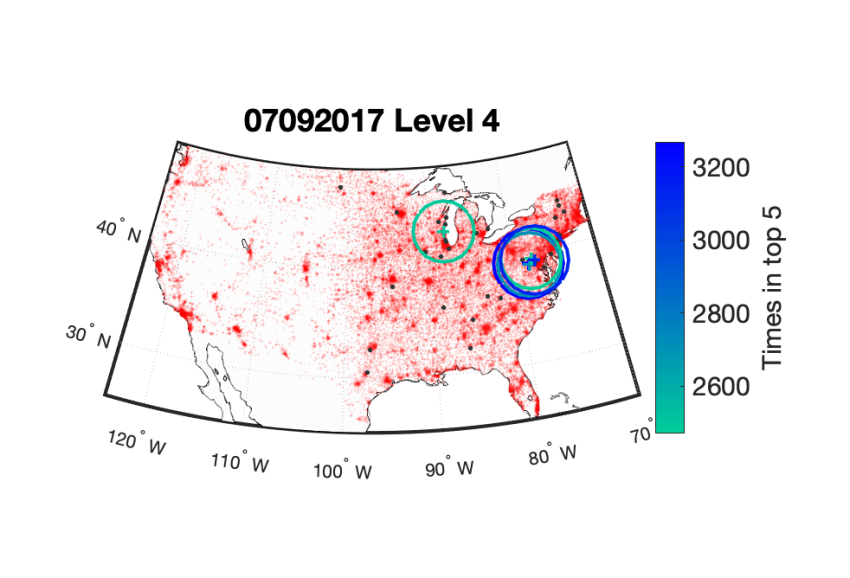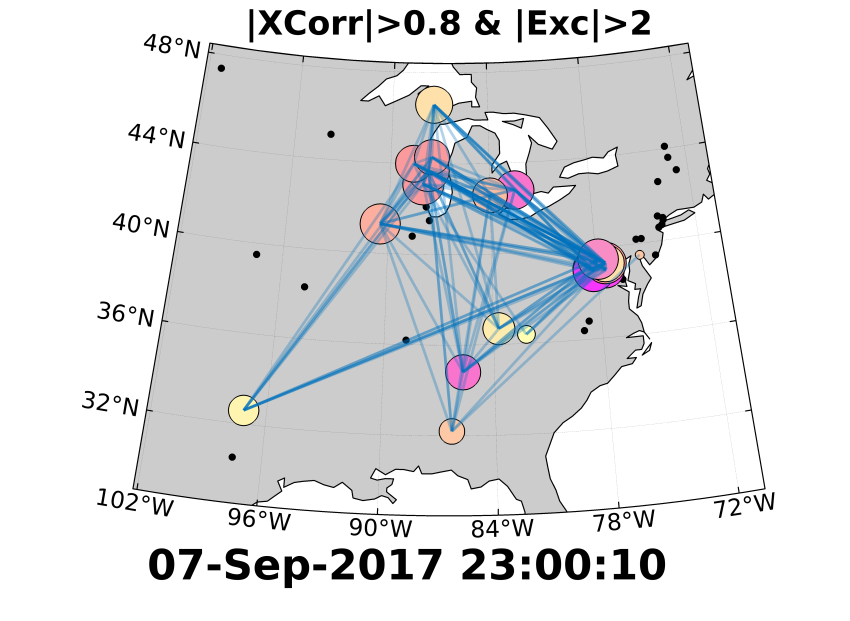Several cities in the United States - including the nation's capital - have power grids particularly vulnerable to the threat of space weather – but experts are still trying to understand why.
Researchers at the British Geological Survey (BGS) found that certain regions of the US are more at risk from geomagnetic storms, which occur when the Sun spits out solar flares and coronal mass ejections (CMEs).
These are bursts of gas and magnetic fields which erupt into space from the solar atmosphere.
They can cause geomagnetic storms that have the potential to damage infrastructure both in Earth's orbit and on its surface, ranging from satellites to underground pipelines.
Two of the cities with power grids found to be most vulnerable to the effects of such space weather are Washington DC and Milwaukee, according to Dr Lauren Orr of the BGS, who is presenting her findings at this week's National Astronomy Meeting at the University of Hull.
"We have identified certain regions of the US (Washington DC area and Milwaukee) which are repeatedly appearing as 'highly connected' in our network, hence are possibly regions particularly vulnerable to the effects of space weather and may benefit from further monitoring," she said.
Dr Orr added that there were "many reasons" the cities may be more at risk to the impact of geomagnetic storms, including "electrical conductivity of the ground, the physical construction of the power grid in those areas, or the location of the auroral currents in the sky".
However, she cautioned that further work was needed to investigate what about these areas makes them so-called 'supernodes' in the network.
Severe space weather is of growing concern to scientists across the globe and is now considered to be as likely to occur as a pandemic, with an impact that is equivalent to extreme temperatures or flooding.
Geomagnetically induced currents (GICs) are one such hazard which can cause damage to power lines and transformers. In the past, widespread blackouts have been reported as a result of transformer damage during geomagnetic storms.
"Network science is now a common tool to quantify the resilience and robustness of power grids to both deliberate attacks and those caused by random failures or natural disasters," Dr Orr explained.
A network is made up of nodes and edges which could be anything from computers linked via the internet, to friends on Facebook, or transformers linked via cables.
"Having previously had great success using network science to uncover patterns within the auroral electrojet we would again combine the fields of network science and space weather to capture the network response to GICs," Dr Orr said.
"By applying known reliability parameters to the GIC network we can identify areas or transformers at high risk."
This is important, she added, because "these areas could be modified during a geomagnetic storm to prevent transformers burning out and to limit damage to the wider power grid".
The work has been carried out in collaboration with Professor Sandra Chapman, of the University of Warwick, and Dr Ryan McGranaghan, of NASA's Jet Propulsion Laboratory in California.
Media contacts
Sam Tonkin
Royal Astronomical Society
Mob +44 (0)7802 877 700
Dr Robert Massey
Royal Astronomical Society
Mob: +44 (0)7802 877 699
Megan Eaves
Royal Astronomical Society
Science contacts
Dr Lauren Orr
British Geological Survey
Images and captions
Locations vulnerable to space weather
Caption: The transformers that are most ‘connected’ to the network throughout the storm and therefore may be locations of vulnerability when it comes to space weather.
Credit: British Geological Survey
Caption: A snapshot of the geomagnetically induced current (GIC) network during an intense solar storm in September 2017.
Credit: British Geological Survey
Notes for editors
The NAM 2024 conference is principally sponsored by the Royal Astronomical Society, the Science and Technology Facilities Council and the University of Hull.
About the Royal Astronomical Society
The Royal Astronomical Society (RAS), founded in 1820, encourages and promotes the study of astronomy, solar-system science, geophysics and closely related branches of science.
The RAS organises scientific meetings, publishes international research and review journals, recognises outstanding achievements by the award of medals and prizes, maintains an extensive library, supports education through grants and outreach activities and represents UK astronomy nationally and internationally. Its more than 4,000 members (Fellows), a third based overseas, include scientific researchers in universities, observatories and laboratories as well as historians of astronomy and others.
The RAS accepts papers for its journals based on the principle of peer review, in which fellow experts on the editorial boards accept the paper as worth considering. The Society issues press releases based on a similar principle, but the organisations and scientists concerned have overall responsibility for their content.
Keep up with the RAS on X, Facebook, LinkedIn and YouTube.
About the Science and Technology Facilities Council
The Science and Technology Facilities Council (STFC) is part of UK Research and Innovation – the UK body which works in partnership with universities, research organisations, businesses, charities, and government to create the best possible environment for research and innovation to flourish.
STFC funds and supports research in particle and nuclear physics, astronomy, gravitational research and astrophysics, and space science and also operates a network of five national laboratories, including the Rutherford Appleton Laboratory and the Daresbury Laboratory, as well as supporting UK research at a number of international research facilities including CERN, FERMILAB, the ESO telescopes in Chile and many more.
STFC's Astronomy and Space Science programme provides support for a wide range of facilities, research groups and individuals in order to investigate some of the highest priority questions in astrophysics, cosmology and solar system science.
STFC's astronomy and space science programme is delivered through grant funding for research activities, and also through support of technical activities at STFC's UK Astronomy Technology Centre and RAL Space at the Rutherford Appleton Laboratory. STFC also supports UK astronomy through the international European Southern Observatory and the Square Kilometre Array Organisation.
Visit https://stfc.ukri.org/ for more information. Follow STFC on Twitter: @STFC_Matters
About the University of Hull's E.A. Milne Centre
The E.A. Milne Centre for Astrophysics at the University of Hull brings together experts who study the evolution of structure in the Universe ranging from stars through to galaxies and galaxy clusters, right up to the largest structures in the cosmos.
The centre employs observations, theory and computational methods in collaboration with international partners. Postgraduate and undergraduate students work alongside staff to understand the wonders of the Universe. Through a series of outreach activities, the centre also aims to share its passion for astronomy and astrophysics with the region and beyond.



